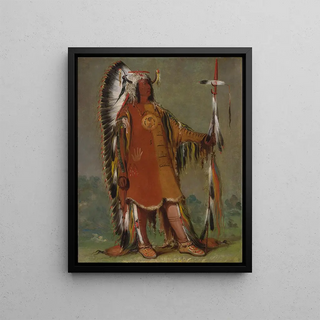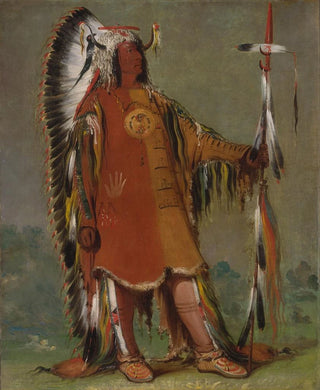Art print Mh-to-th-pa Four Bears Second Chef in formal attire - George Catlin | Art print


View from behind

Frame (optional)
In the vast panorama of American art history, the artwork "Mh-to-th-pa Quatre Ours Second Chef en grande tenue" by George Catlin stands out for its profound visual and cultural impact. This painting, which captures the essence of a bygone era, immerses us in the traditions and rituals of indigenous peoples. Catlin, as a passionate observer, transcended mere representation to offer a true immersion into the universe of the tribes he encountered. The art print of this iconic piece allows us to appreciate not only the artist's technique but also the powerful message he aims to convey about the beauty and richness of Native American cultures.
Style and uniqueness of the work
George Catlin's style is characterized by a meticulous and respectful approach to the subjects he paints. In "Mh-to-th-pa Quatre Ours Second Chef en grande tenue," he manages to capture not only the clothing details and ornaments of the characters but also the intensity of their gazes, revealing psychological depth. The vivid colors and rich textures of the canvas pay homage to the cultural diversity of Native American nations, while demonstrating Catlin's remarkable talent for realistic representation. Every element of the composition, from feathers to clothing patterns, is carefully chosen to evoke an atmosphere of dignity and grandeur, offering an authentic and respectful view of the traditions of the peoples he met during his travels.
The artist and his influence
George Catlin, born in 1796, is often considered the first artist to dedicate his career to the representation of Native American cultures. His commitment to preserving these traditions, at a time when they were threatened by colonial expansion, reflects his forward-thinking vision. Catlin traveled across the American continent, documenting the lifestyles, rituals, and beliefs of the tribes he encountered. His work not only contributed to the understanding of these cultures by the general public but also inspired many artists and ethnographers. Paying homage to figures like Quatre Ours, Catlin succeeded in immortalizing stories and identities

Matte finish

View from behind

Frame (optional)
In the vast panorama of American art history, the artwork "Mh-to-th-pa Quatre Ours Second Chef en grande tenue" by George Catlin stands out for its profound visual and cultural impact. This painting, which captures the essence of a bygone era, immerses us in the traditions and rituals of indigenous peoples. Catlin, as a passionate observer, transcended mere representation to offer a true immersion into the universe of the tribes he encountered. The art print of this iconic piece allows us to appreciate not only the artist's technique but also the powerful message he aims to convey about the beauty and richness of Native American cultures.
Style and uniqueness of the work
George Catlin's style is characterized by a meticulous and respectful approach to the subjects he paints. In "Mh-to-th-pa Quatre Ours Second Chef en grande tenue," he manages to capture not only the clothing details and ornaments of the characters but also the intensity of their gazes, revealing psychological depth. The vivid colors and rich textures of the canvas pay homage to the cultural diversity of Native American nations, while demonstrating Catlin's remarkable talent for realistic representation. Every element of the composition, from feathers to clothing patterns, is carefully chosen to evoke an atmosphere of dignity and grandeur, offering an authentic and respectful view of the traditions of the peoples he met during his travels.
The artist and his influence
George Catlin, born in 1796, is often considered the first artist to dedicate his career to the representation of Native American cultures. His commitment to preserving these traditions, at a time when they were threatened by colonial expansion, reflects his forward-thinking vision. Catlin traveled across the American continent, documenting the lifestyles, rituals, and beliefs of the tribes he encountered. His work not only contributed to the understanding of these cultures by the general public but also inspired many artists and ethnographers. Paying homage to figures like Quatre Ours, Catlin succeeded in immortalizing stories and identities
12,34 €






